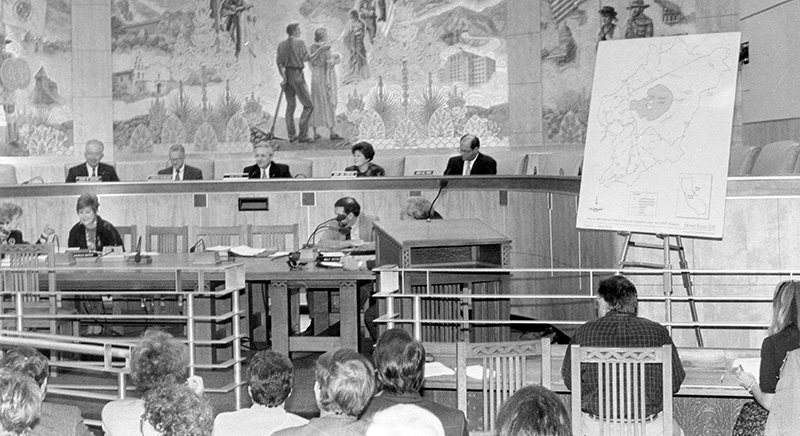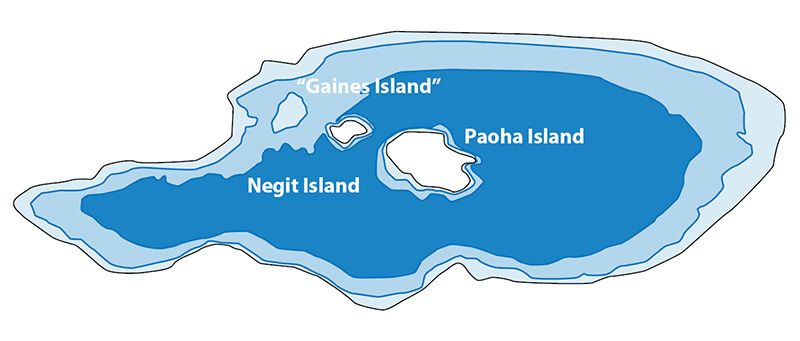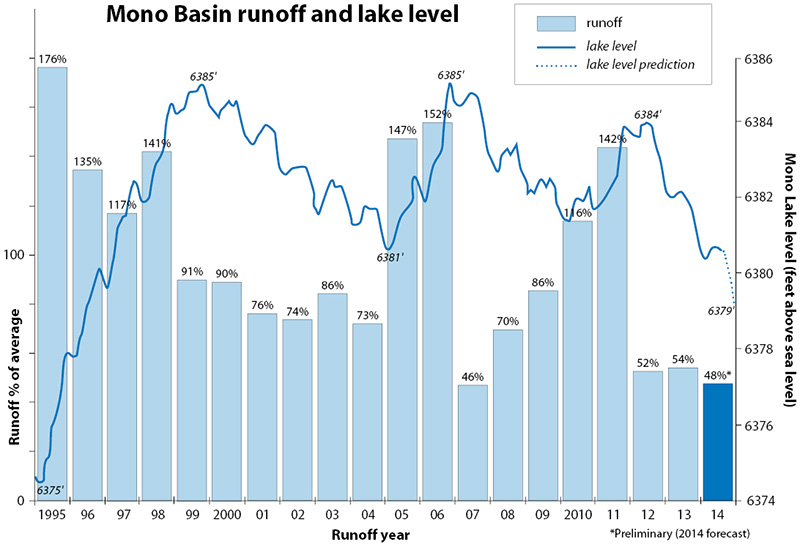
It goes by many names. The Water Board Decision. D1631. The ruling to save Mono Lake. Implementation of the Public Trust Doctrine. The day we took a bite out of the moon. Whatever name you choose, what happened on September 28, 1994 was a momentous day for California and a truly revolutionary one for Mono Lake.

For the prior half-century, excessive water diversions to Los Angeles had put Mono Lake into steep decline, cutting its volume in half, doubling its salinity, drying its streams, and threatening to turn one of the planet’s unique biological wonders to dust.
After that day 20 years ago, everything was different. California had said, in essence, that the old way of managing water was over. A new era that considered the needs of birds and fish and brine shrimp had arrived and, as a result, the Los Angeles Department of Water & Power (DWP) would have to restore much of the damage it had caused.
It was the turning point in Mono Lake’s long recession, the sweet success of a broad-based citizen outcry for more sensible policy, the decision that solved problems ranging from fish habitat to air quality in one fell swoop, the moment when future generations were promised the same opportunity that we have to marvel at the millions of migratory and nesting birds that rely on the lake’s scenic waters.
A vote and an ovation
The decision was issued by the California State Water Resources Control Board, the state agency charged with control of water rights. Thanks to precedent-setting litigation by the Mono Lake Committee and others, it is also charged with protecting the public trust—“the duty of the state to protect the people’s common heritage of streams, lakes, marshlands and tidelands,” in the words of the California Supreme Court.
In 1994, after years of environmental study and 43 days of evidentiary hearings, the State Water Board gathered in the State Capitol, beneath a grand mural depicting California history. As the unanimous vote was cast, Board member Marc del Piero summed it up: “Today we saved Mono Lake.” Seldom do audiences stand to applaud state agency decision-making, but on that historic day the crowd rose as one with a genuine and enthusiastic ovation.
And then, back to work
The Mono Lake Committee promptly published a special celebration issue of the Mono Lake Newsletter: “Assuring the transformation of paper into water, words into wetlands, and ecological health back into the landscape is the work ahead,” it said, setting forth a fundamental theme that will continue to guide us for decades. As we have seen repeatedly, victories are preserved and realized through continuing vigilance.
How are Mono Lake and its tributary streams doing, 20 years later? Is the recovery envisioned by the State Water Board being realized? The lake has fallen painfully due to the current three-year drought, yet the 20-year answers to these important questions are simultaneously positive and incomplete.
We have avoided a dire fate for Mono Lake. We have made much progress with restoration. And yet years and perhaps decades lie ahead before we reach the required management level for the lake, and along the way new questions of ecology and management will challenge us.
The catastrophe we chose to avoid
To evaluate the twentieth anniversary state of affairs at Mono Lake, one must consider what condition the lake would be in otherwise. What if the people of California had not called for change? What if the Committee had never been founded? What if the State Water Board had not taken action? What if—in other words—water diversions by DWP had continued at their full historic levels?
The lake, in that grim scenario, would be a shocking 20 feet lower than it is today. The west shore a vast dry expanse. South Tufa a long slog past dusty land-locked tufa to a barren, tufa-free shore. Negit Island would long ago have been landbridged.
At a surface elevation of 6360 feet above sea level, the lake would be a third smaller in surface area and one million acre-feet of water drier than today—that’s three Hetch Hetchy Reservoirs’ worth of water, gone. Most significantly, the lake would be deep in ecologically unsustainable territory with salinity more than four times that of the Pacific Ocean.

The outcomes of a full-diversion water management scenario were studied by the State Water Board, and the results were jaw-dropping. Brine shrimp and alkali fly numbers would fall by up to 90%, making the food supply for phalaropes, grebes, and migratory birds “low or nonexistent.” California Gull habitat would be virtually destroyed. Shoreline wetlands would be gone, and hazardous dust storms would rage more frequently. Stream habitats for fish and streamside forests would be almost entirely wiped out. The economic benefits of protecting Mono Lake, including tourism and recreation, would evaporate at a cost, in the State Water Board’s estimate, of $1 billion annually.
But this doomsday scenario—so possible decades ago—did not happen. Nor will it. Instead, Mono Lake is where we as citizens, as Californians, as the State Water Board, drew a line, crafted a different future, and said: Long Live Mono Lake!
The up and down of Mono Lake
The restoration of Mono Lake and protection of its wildlife is premised on raising the lake to its mandated ecologically healthy level of 6392 feet above sea level. Human actions—especially the rules about water diversions—are critical to getting there. Yet nature is the ultimate force at work, and few things move in straight-line trajectories, especially amid California’s fluctuating pattern of wet and dry years.
After the State Water Board decision, a string of wet winters rapidly pushed the lake upward, achieving a ten-foot gain to 6385 feet above sea level by 1999. The lake then dropped a few feet, rose up again to 6385′ in 2006, dropped, and rose to 6384′ in 2011. Then the current three-year drought arrived, and we have reluctantly watched the lake fall four feet, exposing sections of lakebed we had hoped to never again see dry.

There is no question that the lake will rise again when wet winters return. The additional time it will now take to reach 6392 feet is sobering, yet at least these fluctuations are taking place within a zone where the ecosystem has resilience; were the lake 20 feet lower, there would be nothing but unbearably bad news to report.
Looking ahead, the fundamental Mono Lake restoration questions that demand our continuing vigilance swirl around climate change. Will Mono Basin precipitation diminish? Are lake surface evaporation rates increasing? Will larger swings in precipitation result in larger lake level fluctuations?
The science of stream restoration
The streams have shown remarkable recovery in certain ways—adding water to dry channels does wonderful things for trees and fisheries. At the same time, infrastructure limitations of the Los Angeles Aqueduct have held back restoration. In the 20 years since D1631, the streams have received a tremendous amount of scientific investigation.
Happily, here at the 20-year mark, we can celebrate that we are turning that scientific knowledge into the next wave of on-the-ground stream restoration. Last year’s landmark Mono Basin Stream Restoration Agreement is a turning point in restoring Rush, Lee Vining, Parker, and Walker creeks to health. Construction of the new outlet in Grant Dam and the implementation of streamflows that mimic natural snowmelt patterns will be a huge restoration advance. The Committee’s job is to make sure these settlement provisions are fully implemented.
The surprises of two decades
Even with the best studies in hand, you can be sure that natural systems will develop and change in unexpected ways over time. For the Mono Lake ecosystem, some surprises have happened since 1994, and Mono Lake restoration must take them into account.
Lake mixing dynamics
Mono Lake commonly stratifies for part of the year when warm and less saline upper waters are too light to mix with denser, colder deep waters. During this time, nutrients collect in the lower levels of the lake and are unavailable to phytoplankton and brine shrimp. The colder temperatures and windy conditions of winter typically cause this stratification to break down, resulting in a full mixing of lake nutrients and waters.
In the eight years after the State Water board decision, what came as a surprise was the onset of meromixis—persistent stratification conditions. A series of wet winters produced high freshwater inflows; with the lake at half its natural size, stratification locked in, trapping nutrients and limiting the lake’s productivity. Meromixis broke down naturally in 2003; however, it continues to confound long-term trend analysis in lake productivity today.
Brine shrimp dynamics
A clear long-term trend of change has emerged in the dynamics of the Mono Lake brine shrimp population—the annual population pattern is shifting in time. In the spring, the first generation of shrimp to hatch is more numerous and emerges earlier than in decades past. By autumn, the total shrimp population tends to be smaller in numbers and to decline more rapidly. This means that Mono Lake continues to be an excellent food resource for gulls, phalaropes, and grebes, but the best season for snacking is shifting earlier in the year. This is likely causing millions of Eared Grebes to migrate south earlier in the fall than they used to.
Large-scale dynamic change of this kind would be hidden from us without consistent scientific monitoring to understand Mono Lake. The Committee continues to safeguard the integrity of the State Water Board-mandated Mono Lake limnology monitoring program. The Committee also sponsors species-level monitoring of California Gulls, and arranges a volunteer effort to census Eared Grebes.
Osprey thrive
In 1994, the State Water Board cautiously noted that its decision “may have some beneficial effect on ospreys.” How right they turned out to be: Osprey have joined gulls, grebes, and phalaropes as emblematic birds for Mono Lake visitors. Their large nests balance atop tufa towers around the lake and they thrive on the fish of the rewatered tributary streams. Ten nests were active last year, fledging an impressive 20 chicks. The inspiring sight of an Osprey swooping above tufa with a trout in its talons is a marker of the widespread benefits of protecting Mono Lake.
The ongoing work of the public trust
Be it brine shrimp health, flocks of phalaropes, stream restoration, or protection of air quality, the many dimensions of the 1994 State Water Board decision are all part of protecting Mono Lake and its outstanding public trust resources.
Public trust protection has often been envisioned as a legal action done at a single moment in time—in a ruling, decision, or order. At Mono Lake, 20 years have taught us that, instead, public trust protection is continual, constant work. It is the duty of the State Water Board. It is an obligation of DWP. It most certainly is the work of the Mono Lake Committee and all of us who care for this special place. In the words of the late public trust scholar Professor Joseph Sax, “it is the ongoing willingness of society to invest in public trust protection that demonstrates its lasting significance.”
This post was also published as an article in the Summer 2014 Mono Lake Newsletter.

[…] Mono Lake decision at 20: The Mono-Logue Blog writes: “It goes by many names. The Water Board Decision. D1631. The ruling to save Mono Lake. Implementation of the Public Trust Doctrine. The day we took a bite out of the moon. Whatever name you choose, what happened on September 28, 1994 was a momentous day for California and a truly revolutionary one for Mono Lake. For the prior half-century, excessive water diversions to Los Angeles had put Mono Lake into steep decline, cutting its volume in half, doubling its salinity, drying its streams, and threatening to turn one of the planet’s unique biological wonders to dust. … ” Read more from the Mono Lake Committee here: The State Water Board decision at 20 […]